Wi-Fi Robots: A Comprehensive Guide
VerifiedAdded on 2023/06/12
|7
|1477
|77
AI Summary
This report provides a comprehensive guide to Wi-Fi robots, including their background, functionality, and potential for commercial usage. It covers the misconceptions about robots, the role of microcontrollers and sensors, and the hardware setup of Wi-Fi robots. The report also discusses the benefits of Wi-Fi technology and its compatibility with other devices. Overall, this report is a must-read for anyone interested in Wi-Fi robots.
Contribute Materials
Your contribution can guide someone’s learning journey. Share your
documents today.

Running head: WIFI ROBOTS
WIFI ROBOTS
University Name
Student name
Student Number
Teaching Staff
WIFI ROBOTS
University Name
Student name
Student Number
Teaching Staff
Secure Best Marks with AI Grader
Need help grading? Try our AI Grader for instant feedback on your assignments.

1WIFI ROBOTS
Table of Contents
Introduction................................................................................................................................2
Background................................................................................................................................2
Conclusion..................................................................................................................................5
References..................................................................................................................................6
Table of Contents
Introduction................................................................................................................................2
Background................................................................................................................................2
Conclusion..................................................................................................................................5
References..................................................................................................................................6
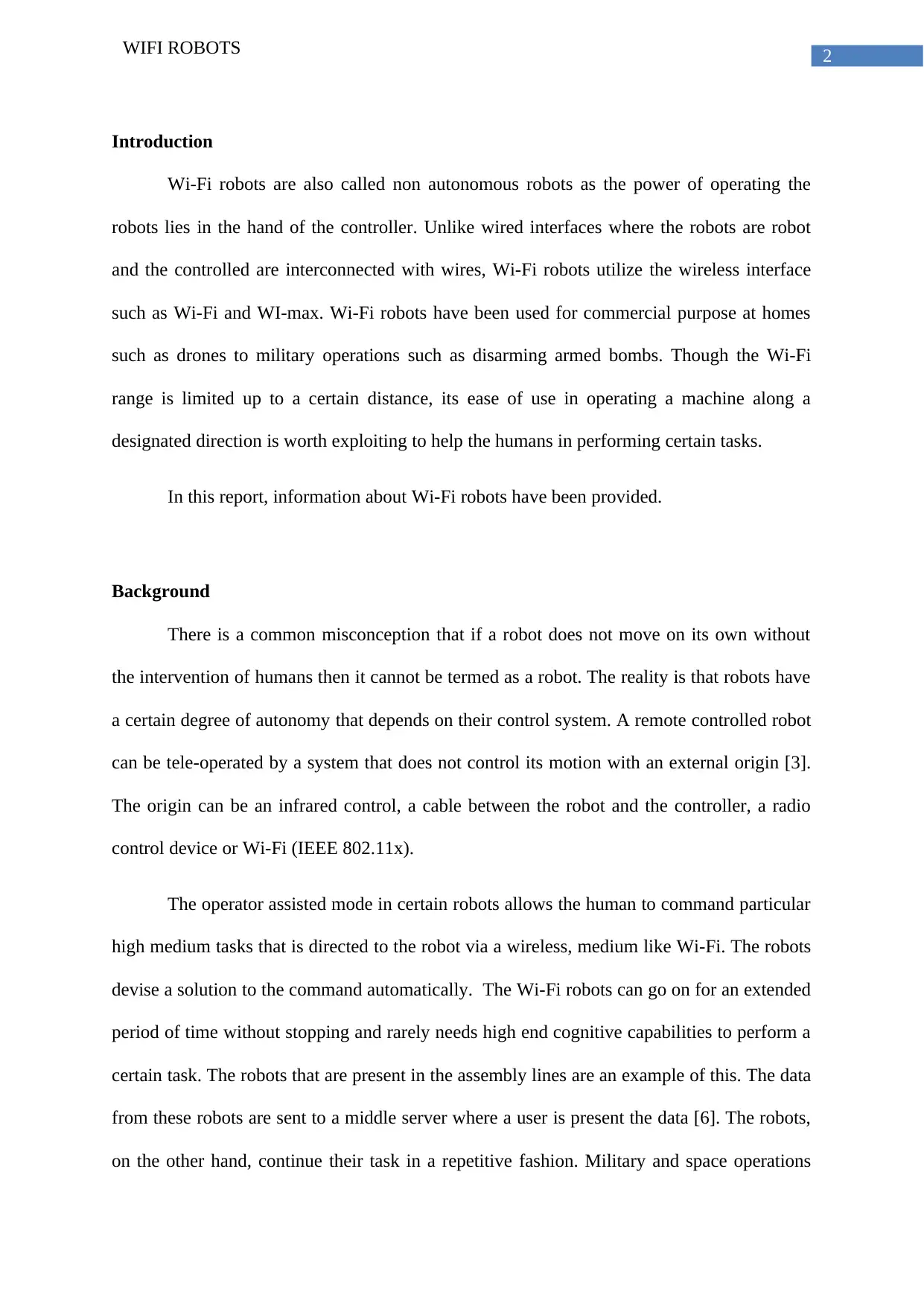
2WIFI ROBOTS
Introduction
Wi-Fi robots are also called non autonomous robots as the power of operating the
robots lies in the hand of the controller. Unlike wired interfaces where the robots are robot
and the controlled are interconnected with wires, Wi-Fi robots utilize the wireless interface
such as Wi-Fi and WI-max. Wi-Fi robots have been used for commercial purpose at homes
such as drones to military operations such as disarming armed bombs. Though the Wi-Fi
range is limited up to a certain distance, its ease of use in operating a machine along a
designated direction is worth exploiting to help the humans in performing certain tasks.
In this report, information about Wi-Fi robots have been provided.
Background
There is a common misconception that if a robot does not move on its own without
the intervention of humans then it cannot be termed as a robot. The reality is that robots have
a certain degree of autonomy that depends on their control system. A remote controlled robot
can be tele-operated by a system that does not control its motion with an external origin [3].
The origin can be an infrared control, a cable between the robot and the controller, a radio
control device or Wi-Fi (IEEE 802.11x).
The operator assisted mode in certain robots allows the human to command particular
high medium tasks that is directed to the robot via a wireless, medium like Wi-Fi. The robots
devise a solution to the command automatically. The Wi-Fi robots can go on for an extended
period of time without stopping and rarely needs high end cognitive capabilities to perform a
certain task. The robots that are present in the assembly lines are an example of this. The data
from these robots are sent to a middle server where a user is present the data [6]. The robots,
on the other hand, continue their task in a repetitive fashion. Military and space operations
Introduction
Wi-Fi robots are also called non autonomous robots as the power of operating the
robots lies in the hand of the controller. Unlike wired interfaces where the robots are robot
and the controlled are interconnected with wires, Wi-Fi robots utilize the wireless interface
such as Wi-Fi and WI-max. Wi-Fi robots have been used for commercial purpose at homes
such as drones to military operations such as disarming armed bombs. Though the Wi-Fi
range is limited up to a certain distance, its ease of use in operating a machine along a
designated direction is worth exploiting to help the humans in performing certain tasks.
In this report, information about Wi-Fi robots have been provided.
Background
There is a common misconception that if a robot does not move on its own without
the intervention of humans then it cannot be termed as a robot. The reality is that robots have
a certain degree of autonomy that depends on their control system. A remote controlled robot
can be tele-operated by a system that does not control its motion with an external origin [3].
The origin can be an infrared control, a cable between the robot and the controller, a radio
control device or Wi-Fi (IEEE 802.11x).
The operator assisted mode in certain robots allows the human to command particular
high medium tasks that is directed to the robot via a wireless, medium like Wi-Fi. The robots
devise a solution to the command automatically. The Wi-Fi robots can go on for an extended
period of time without stopping and rarely needs high end cognitive capabilities to perform a
certain task. The robots that are present in the assembly lines are an example of this. The data
from these robots are sent to a middle server where a user is present the data [6]. The robots,
on the other hand, continue their task in a repetitive fashion. Military and space operations
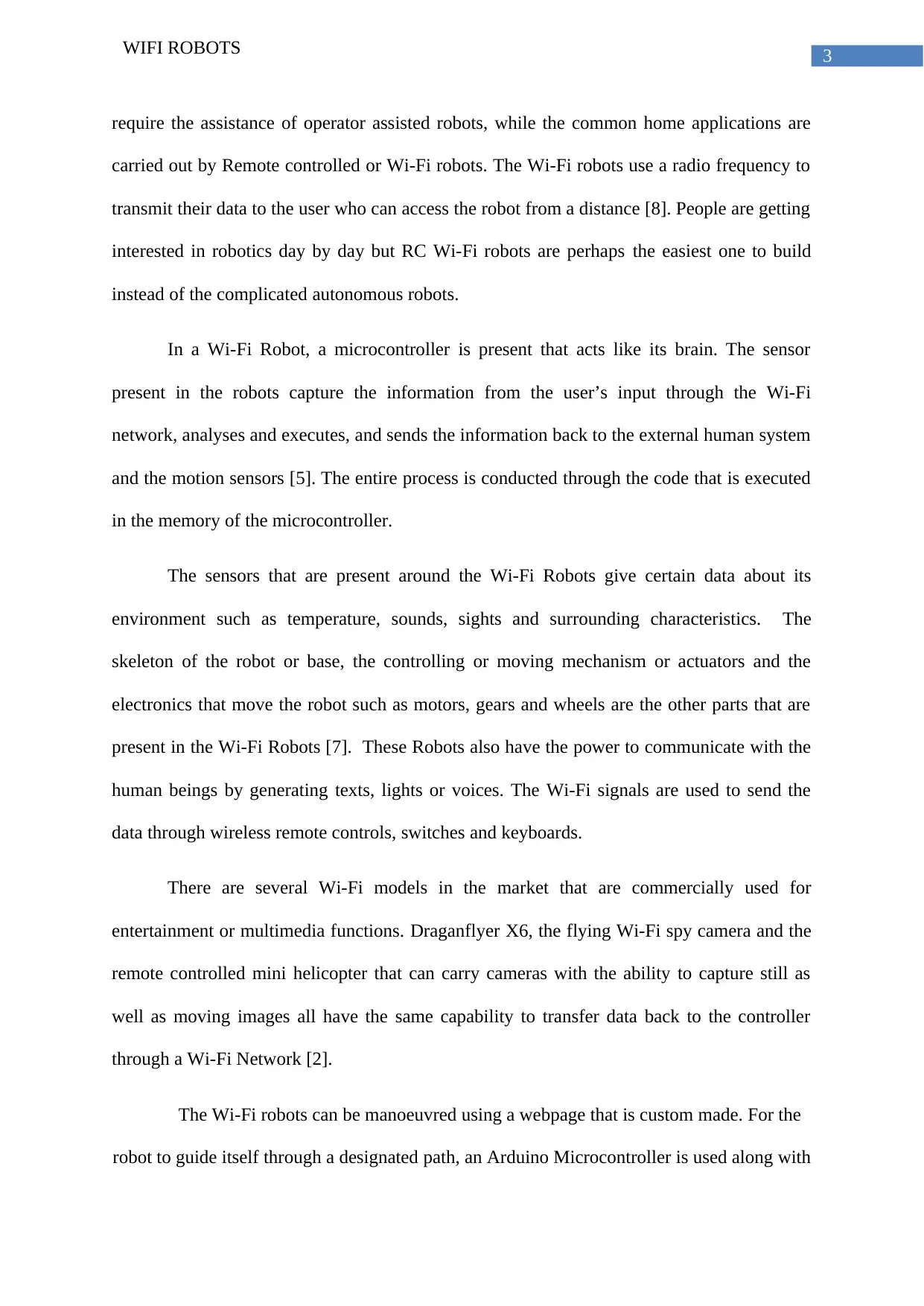
3WIFI ROBOTS
require the assistance of operator assisted robots, while the common home applications are
carried out by Remote controlled or Wi-Fi robots. The Wi-Fi robots use a radio frequency to
transmit their data to the user who can access the robot from a distance [8]. People are getting
interested in robotics day by day but RC Wi-Fi robots are perhaps the easiest one to build
instead of the complicated autonomous robots.
In a Wi-Fi Robot, a microcontroller is present that acts like its brain. The sensor
present in the robots capture the information from the user’s input through the Wi-Fi
network, analyses and executes, and sends the information back to the external human system
and the motion sensors [5]. The entire process is conducted through the code that is executed
in the memory of the microcontroller.
The sensors that are present around the Wi-Fi Robots give certain data about its
environment such as temperature, sounds, sights and surrounding characteristics. The
skeleton of the robot or base, the controlling or moving mechanism or actuators and the
electronics that move the robot such as motors, gears and wheels are the other parts that are
present in the Wi-Fi Robots [7]. These Robots also have the power to communicate with the
human beings by generating texts, lights or voices. The Wi-Fi signals are used to send the
data through wireless remote controls, switches and keyboards.
There are several Wi-Fi models in the market that are commercially used for
entertainment or multimedia functions. Draganflyer X6, the flying Wi-Fi spy camera and the
remote controlled mini helicopter that can carry cameras with the ability to capture still as
well as moving images all have the same capability to transfer data back to the controller
through a Wi-Fi Network [2].
The Wi-Fi robots can be manoeuvred using a webpage that is custom made. For the
robot to guide itself through a designated path, an Arduino Microcontroller is used along with
require the assistance of operator assisted robots, while the common home applications are
carried out by Remote controlled or Wi-Fi robots. The Wi-Fi robots use a radio frequency to
transmit their data to the user who can access the robot from a distance [8]. People are getting
interested in robotics day by day but RC Wi-Fi robots are perhaps the easiest one to build
instead of the complicated autonomous robots.
In a Wi-Fi Robot, a microcontroller is present that acts like its brain. The sensor
present in the robots capture the information from the user’s input through the Wi-Fi
network, analyses and executes, and sends the information back to the external human system
and the motion sensors [5]. The entire process is conducted through the code that is executed
in the memory of the microcontroller.
The sensors that are present around the Wi-Fi Robots give certain data about its
environment such as temperature, sounds, sights and surrounding characteristics. The
skeleton of the robot or base, the controlling or moving mechanism or actuators and the
electronics that move the robot such as motors, gears and wheels are the other parts that are
present in the Wi-Fi Robots [7]. These Robots also have the power to communicate with the
human beings by generating texts, lights or voices. The Wi-Fi signals are used to send the
data through wireless remote controls, switches and keyboards.
There are several Wi-Fi models in the market that are commercially used for
entertainment or multimedia functions. Draganflyer X6, the flying Wi-Fi spy camera and the
remote controlled mini helicopter that can carry cameras with the ability to capture still as
well as moving images all have the same capability to transfer data back to the controller
through a Wi-Fi Network [2].
The Wi-Fi robots can be manoeuvred using a webpage that is custom made. For the
robot to guide itself through a designated path, an Arduino Microcontroller is used along with
Secure Best Marks with AI Grader
Need help grading? Try our AI Grader for instant feedback on your assignments.
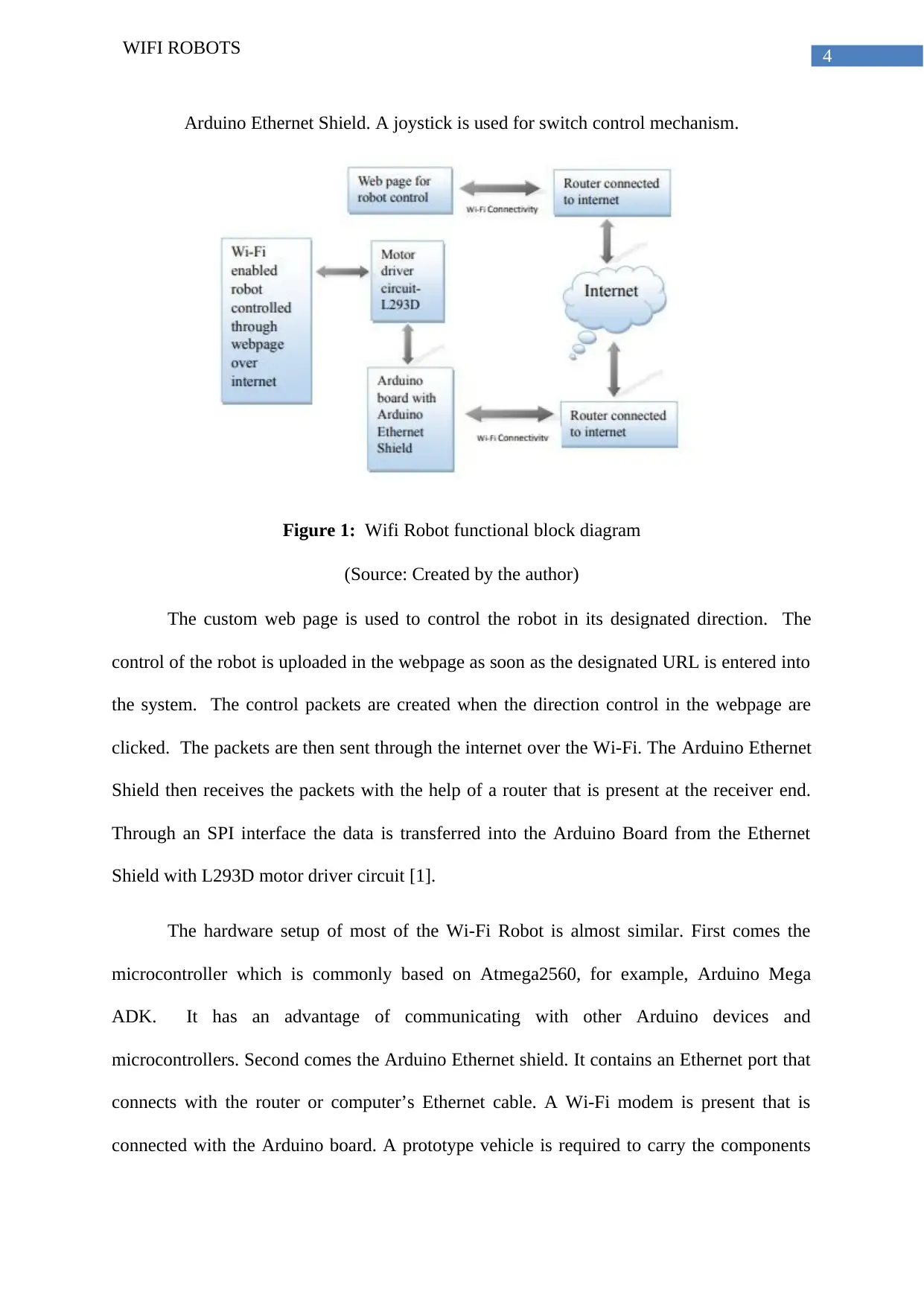
4WIFI ROBOTS
Arduino Ethernet Shield. A joystick is used for switch control mechanism.
Figure 1: Wifi Robot functional block diagram
(Source: Created by the author)
The custom web page is used to control the robot in its designated direction. The
control of the robot is uploaded in the webpage as soon as the designated URL is entered into
the system. The control packets are created when the direction control in the webpage are
clicked. The packets are then sent through the internet over the Wi-Fi. The Arduino Ethernet
Shield then receives the packets with the help of a router that is present at the receiver end.
Through an SPI interface the data is transferred into the Arduino Board from the Ethernet
Shield with L293D motor driver circuit [1].
The hardware setup of most of the Wi-Fi Robot is almost similar. First comes the
microcontroller which is commonly based on Atmega2560, for example, Arduino Mega
ADK. It has an advantage of communicating with other Arduino devices and
microcontrollers. Second comes the Arduino Ethernet shield. It contains an Ethernet port that
connects with the router or computer’s Ethernet cable. A Wi-Fi modem is present that is
connected with the Arduino board. A prototype vehicle is required to carry the components
Arduino Ethernet Shield. A joystick is used for switch control mechanism.
Figure 1: Wifi Robot functional block diagram
(Source: Created by the author)
The custom web page is used to control the robot in its designated direction. The
control of the robot is uploaded in the webpage as soon as the designated URL is entered into
the system. The control packets are created when the direction control in the webpage are
clicked. The packets are then sent through the internet over the Wi-Fi. The Arduino Ethernet
Shield then receives the packets with the help of a router that is present at the receiver end.
Through an SPI interface the data is transferred into the Arduino Board from the Ethernet
Shield with L293D motor driver circuit [1].
The hardware setup of most of the Wi-Fi Robot is almost similar. First comes the
microcontroller which is commonly based on Atmega2560, for example, Arduino Mega
ADK. It has an advantage of communicating with other Arduino devices and
microcontrollers. Second comes the Arduino Ethernet shield. It contains an Ethernet port that
connects with the router or computer’s Ethernet cable. A Wi-Fi modem is present that is
connected with the Arduino board. A prototype vehicle is required to carry the components
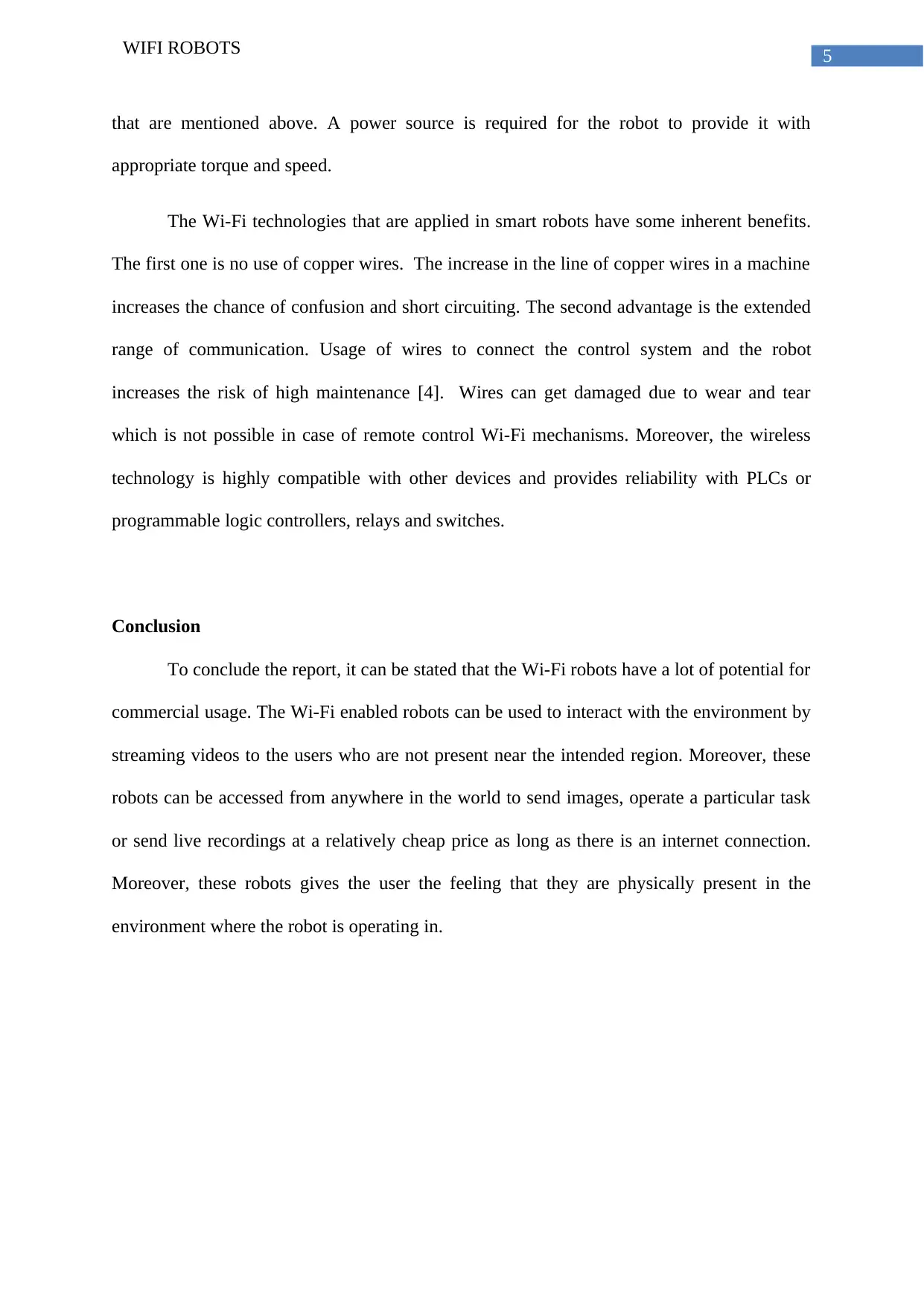
5WIFI ROBOTS
that are mentioned above. A power source is required for the robot to provide it with
appropriate torque and speed.
The Wi-Fi technologies that are applied in smart robots have some inherent benefits.
The first one is no use of copper wires. The increase in the line of copper wires in a machine
increases the chance of confusion and short circuiting. The second advantage is the extended
range of communication. Usage of wires to connect the control system and the robot
increases the risk of high maintenance [4]. Wires can get damaged due to wear and tear
which is not possible in case of remote control Wi-Fi mechanisms. Moreover, the wireless
technology is highly compatible with other devices and provides reliability with PLCs or
programmable logic controllers, relays and switches.
Conclusion
To conclude the report, it can be stated that the Wi-Fi robots have a lot of potential for
commercial usage. The Wi-Fi enabled robots can be used to interact with the environment by
streaming videos to the users who are not present near the intended region. Moreover, these
robots can be accessed from anywhere in the world to send images, operate a particular task
or send live recordings at a relatively cheap price as long as there is an internet connection.
Moreover, these robots gives the user the feeling that they are physically present in the
environment where the robot is operating in.
that are mentioned above. A power source is required for the robot to provide it with
appropriate torque and speed.
The Wi-Fi technologies that are applied in smart robots have some inherent benefits.
The first one is no use of copper wires. The increase in the line of copper wires in a machine
increases the chance of confusion and short circuiting. The second advantage is the extended
range of communication. Usage of wires to connect the control system and the robot
increases the risk of high maintenance [4]. Wires can get damaged due to wear and tear
which is not possible in case of remote control Wi-Fi mechanisms. Moreover, the wireless
technology is highly compatible with other devices and provides reliability with PLCs or
programmable logic controllers, relays and switches.
Conclusion
To conclude the report, it can be stated that the Wi-Fi robots have a lot of potential for
commercial usage. The Wi-Fi enabled robots can be used to interact with the environment by
streaming videos to the users who are not present near the intended region. Moreover, these
robots can be accessed from anywhere in the world to send images, operate a particular task
or send live recordings at a relatively cheap price as long as there is an internet connection.
Moreover, these robots gives the user the feeling that they are physically present in the
environment where the robot is operating in.
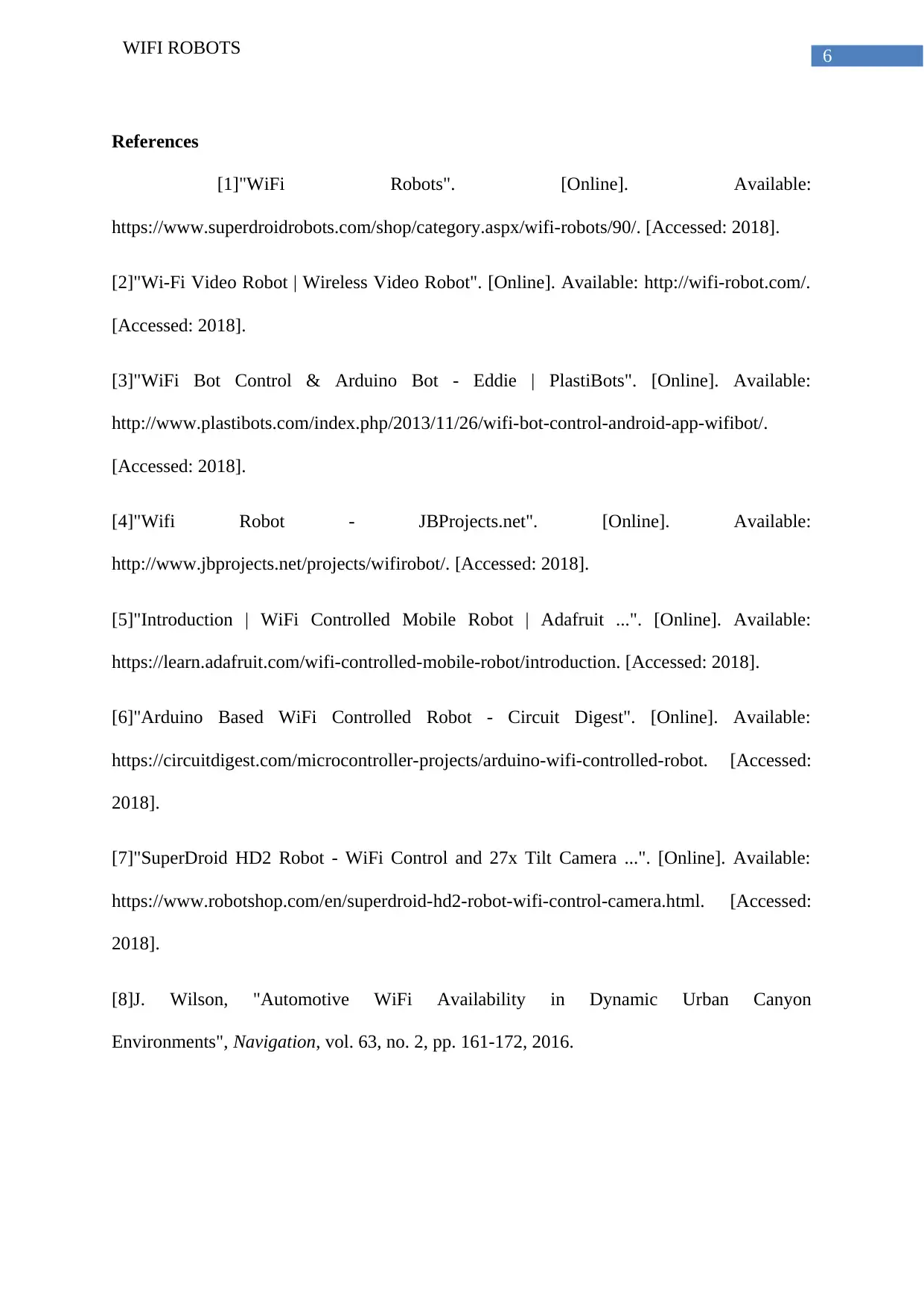
6WIFI ROBOTS
References
[1]"WiFi Robots". [Online]. Available:
https://www.superdroidrobots.com/shop/category.aspx/wifi-robots/90/. [Accessed: 2018].
[2]"Wi-Fi Video Robot | Wireless Video Robot". [Online]. Available: http://wifi-robot.com/.
[Accessed: 2018].
[3]"WiFi Bot Control & Arduino Bot - Eddie | PlastiBots". [Online]. Available:
http://www.plastibots.com/index.php/2013/11/26/wifi-bot-control-android-app-wifibot/.
[Accessed: 2018].
[4]"Wifi Robot - JBProjects.net". [Online]. Available:
http://www.jbprojects.net/projects/wifirobot/. [Accessed: 2018].
[5]"Introduction | WiFi Controlled Mobile Robot | Adafruit ...". [Online]. Available:
https://learn.adafruit.com/wifi-controlled-mobile-robot/introduction. [Accessed: 2018].
[6]"Arduino Based WiFi Controlled Robot - Circuit Digest". [Online]. Available:
https://circuitdigest.com/microcontroller-projects/arduino-wifi-controlled-robot. [Accessed:
2018].
[7]"SuperDroid HD2 Robot - WiFi Control and 27x Tilt Camera ...". [Online]. Available:
https://www.robotshop.com/en/superdroid-hd2-robot-wifi-control-camera.html. [Accessed:
2018].
[8]J. Wilson, "Automotive WiFi Availability in Dynamic Urban Canyon
Environments", Navigation, vol. 63, no. 2, pp. 161-172, 2016.
References
[1]"WiFi Robots". [Online]. Available:
https://www.superdroidrobots.com/shop/category.aspx/wifi-robots/90/. [Accessed: 2018].
[2]"Wi-Fi Video Robot | Wireless Video Robot". [Online]. Available: http://wifi-robot.com/.
[Accessed: 2018].
[3]"WiFi Bot Control & Arduino Bot - Eddie | PlastiBots". [Online]. Available:
http://www.plastibots.com/index.php/2013/11/26/wifi-bot-control-android-app-wifibot/.
[Accessed: 2018].
[4]"Wifi Robot - JBProjects.net". [Online]. Available:
http://www.jbprojects.net/projects/wifirobot/. [Accessed: 2018].
[5]"Introduction | WiFi Controlled Mobile Robot | Adafruit ...". [Online]. Available:
https://learn.adafruit.com/wifi-controlled-mobile-robot/introduction. [Accessed: 2018].
[6]"Arduino Based WiFi Controlled Robot - Circuit Digest". [Online]. Available:
https://circuitdigest.com/microcontroller-projects/arduino-wifi-controlled-robot. [Accessed:
2018].
[7]"SuperDroid HD2 Robot - WiFi Control and 27x Tilt Camera ...". [Online]. Available:
https://www.robotshop.com/en/superdroid-hd2-robot-wifi-control-camera.html. [Accessed:
2018].
[8]J. Wilson, "Automotive WiFi Availability in Dynamic Urban Canyon
Environments", Navigation, vol. 63, no. 2, pp. 161-172, 2016.
1 out of 7
Related Documents
Your All-in-One AI-Powered Toolkit for Academic Success.
+13062052269
info@desklib.com
Available 24*7 on WhatsApp / Email
![[object Object]](/_next/static/media/star-bottom.7253800d.svg)
Unlock your academic potential
© 2024 | Zucol Services PVT LTD | All rights reserved.





